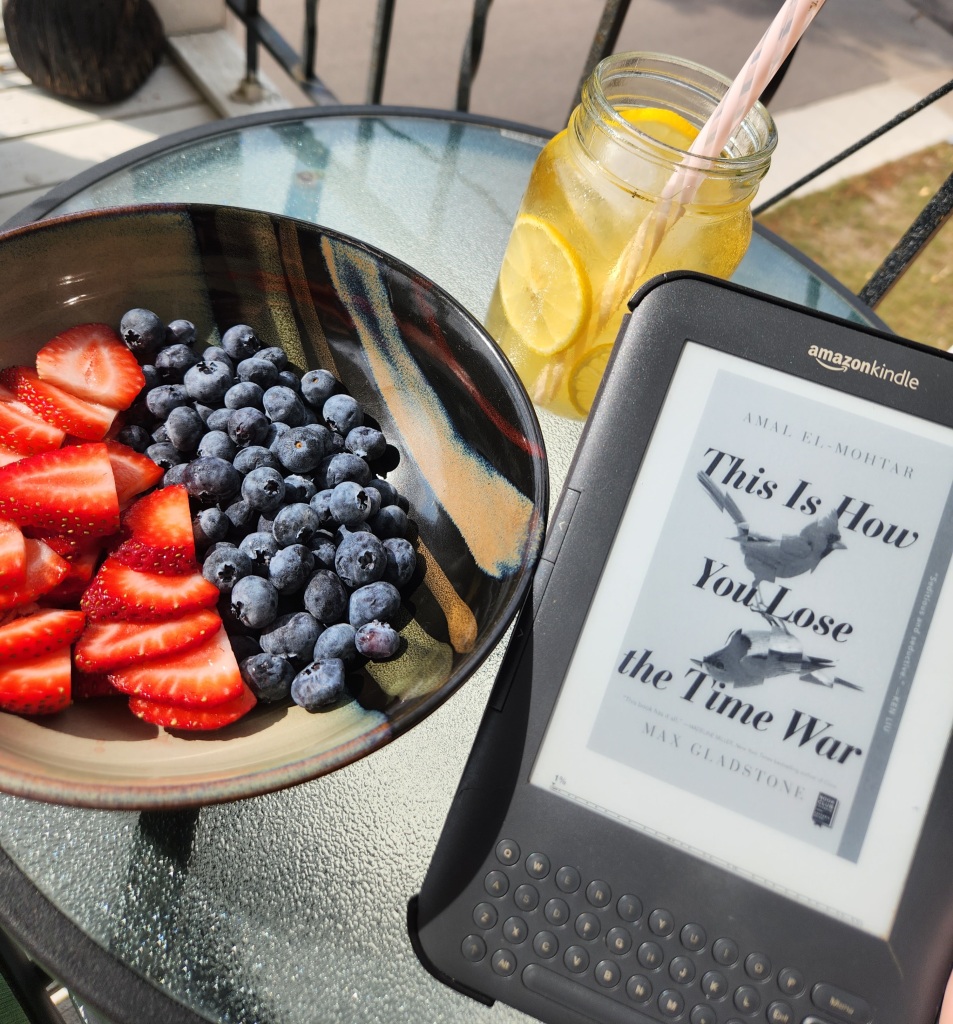
Review #57: Fiction
This Is How You Lose the Time War by Amal El-Mohtar and Max Gladstone
This is such a unique story, there’s nothing to do but jump right in. Red and Blue are two operatives of competing agencies dedicated to the upkeep of their own idea of the correct version of time (think Loki and the TVA). Each works to change, or prevent changes, in time to bring about the future they believe is right. Red and Blue jump through time disrupting events, or cleaning up said disruption, and setting traps and leaving antagonistic notes for each other to find – egging each other on. However, these notes are against the rules of their time war, and someone is following them through time, spying on them—The Seeker—so their methods of communication need to be clever and untraceable. As their correspondence becomes more personal, and loses its antagonistic tone, Red and Blue must fight against everything they know, everything they’ve been fighting to uphold, to keep each other safe. Afterall, what good is all the time in the world without love? In This Is How You Lose the Time War, El-Mohtar and Gladstone weave an intricate enemies-to-lovers story within the threads of time.
To be honest, I found it a bit difficult to visualize the characters, and I think rereading would lend itself well to build more concrete understandings of not just physical attributes, but also of origin of existence. From what I gathered, Blue is from an agency of sentient machines, with a consciousness that seems to be AI of some kind. This agency seems to be made up of agents that are built. Red, conversely, seems to be from a larger consciousness, grown in nutrient pods, that is given individual organic bodies to work and travel through time. Eating is mentioned as something that is done for fun, not necessity. I imagined a humanistic body for both Red and Blue, though Blue is more a metal skeleton with a human looking shell (not unlike the Terminator). Both are also referred to with she/her pronouns which let me visualize more feminine features and make this a queer love story.
This Is How You Lose the Time War is told through scenes of time travel and the secret letters sent between Red and Blue. Both scene and letter flow like prose poetry; it’s all very flowery and fluid, slippery and slow and wistful. There’s a romance that is so prevalent but almost also out of reach and understanding, like we’re grasping at smoke as it dissipates. This feeling of knowing but not knowing is heightened because the letters that Red and Blue leave for each other are not written (a form that could be so easily intercepted spelling disaster for each of them) but woven into the threads of the time they’re visiting, made into chemical reactions and food and lava and tree bark and tea leaves.
These letters are so intimate. I found myself almost blushing, bashful, as if they aren’t meant for anyone else to read. They are beautiful, and vulnerable, not overly sexual but sensual and sexy. The dynamic between Red and Blue reminded me of Crowley and Aziraphale from Good Omens. Something exists between them that is so pure and deeply ingrained that they must be soulmates.
SPOILERS AHEAD
Though the exact nature of Red and Blue’s relationship is not found out, Red’s agency begins to suspect something may be going on, and they find Blue to be a major threat to their cause. Red is tasked with illuminating Blue, hiding poison in a letter. Red tries to warn Blue, tells her not to open any more letters from her, ever. She knows it means never communicating with Blue ever again, but Red knows the sacrifice is worth Blue’s life. Blue doesn’t listen. She knows the letter is poison, but now knowing a life with Red, would rather die than never hear from her again.
The Seeker that has been watching, following Red and Blue through time, and we believe attempting to catch them corresponding, to punish them, is seemingly revealed to be Red. After creating the poisonous letter, she returns through time to all the moments she and Blue had left letters, even back to a time when Blue was young and nearly died. Red has been infusing parts of Blue into herself through time, she infects Blue as a child, nearly killing her, but leaving part of her own biology behind in Blue. Red has done the only thing she can think of, mixing herself with Blue, leaving enough of herself in Blue to hopefully inoculate her to the poison that Red will leave for her so many years later. I was reminded of Interstellar when the was revealed.
This love story, told through the most imaginative of means, across time and space, is one of the most genuine, beautiful, and raw love stories I’ve ever read. Though so much is blurry and out of reach, the love is fully tangible and leaves no question. I cannot wait to reread this, as I’m sure this is a book that will expose more and more of itself with each read. A book that is both devastating and hopeful, This Is How You Lost the Time War will become a timeless classic in both sci-fi and romance.
My rating: 4.5 out of 5 stars
📚📸 : @_amber.reads.a.book_

